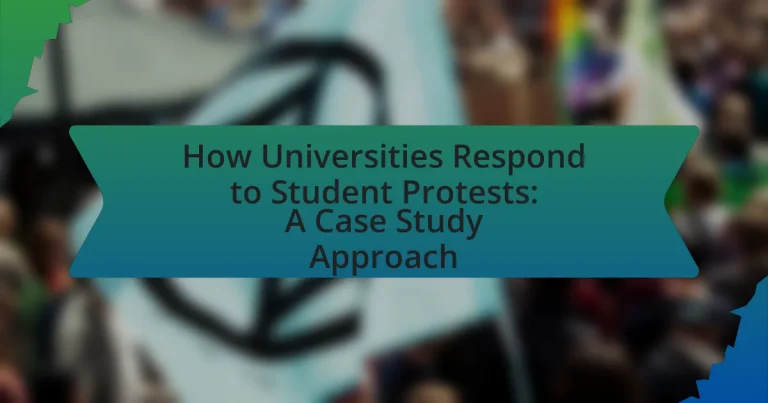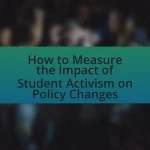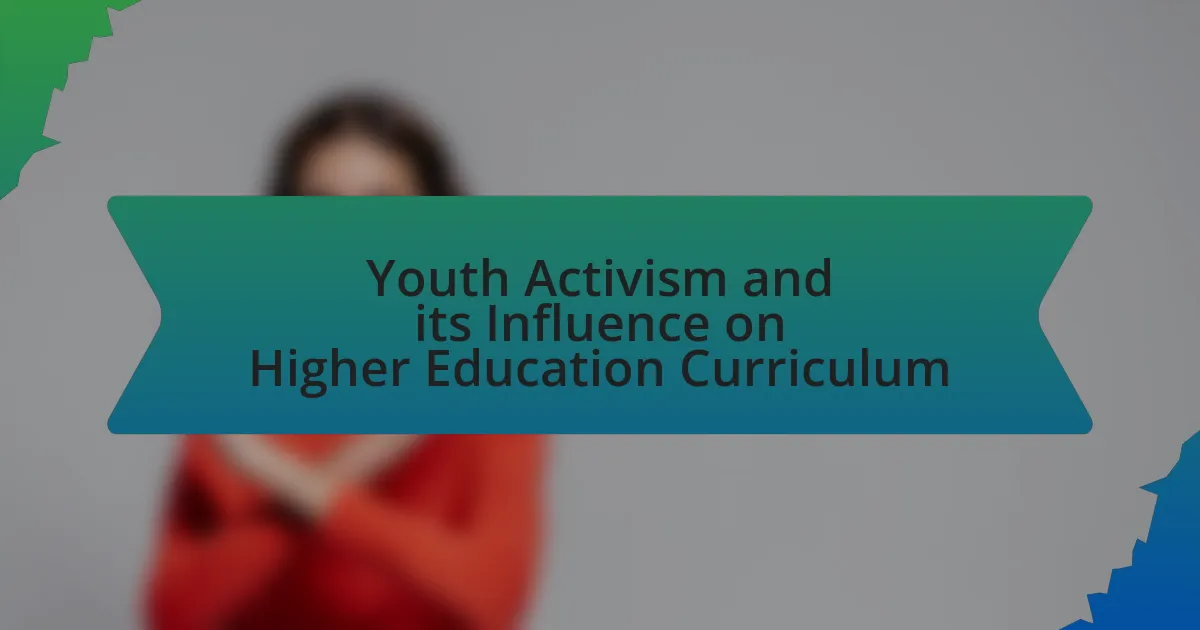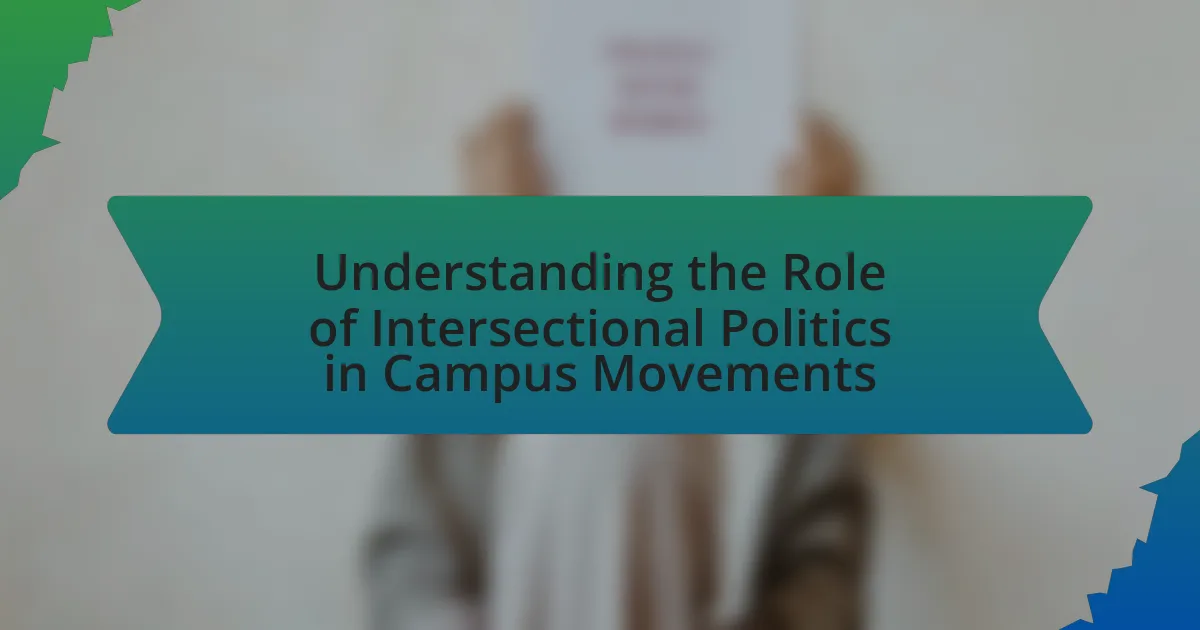The article examines how universities respond to student protests, highlighting the dual approach of dialogue and disciplinary actions. It explores common motivations behind student activism, such as social justice and educational reform, and the influence of campus culture on protest dynamics. The article analyzes various strategies employed by universities, including policy adjustments and communication efforts, to balance free speech with safety. It also discusses the implications of administrative responses on student relations and future activism, emphasizing the importance of transparency and collaboration in fostering constructive dialogue. Case studies illustrate diverse institutional responses and outcomes, providing insights into effective protest management practices.
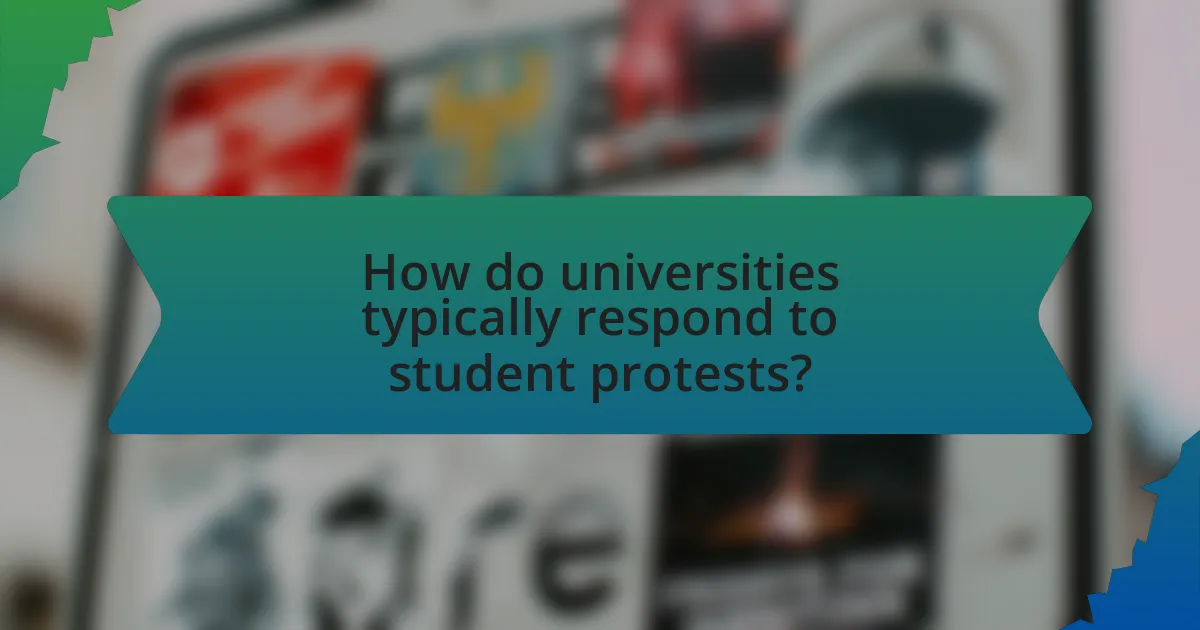
How do universities typically respond to student protests?
Universities typically respond to student protests through a combination of dialogue, policy review, and sometimes disciplinary actions. When students organize protests, university administrations often initiate discussions to understand the concerns being raised, aiming to address issues such as social justice, tuition fees, or campus policies. For instance, the University of California system has a history of engaging with student groups to negotiate changes in policy following protests, demonstrating a commitment to dialogue. However, in some cases, universities may also implement disciplinary measures against students if protests escalate to disruptive behavior, as seen in incidents at institutions like Yale University. This dual approach of engagement and enforcement reflects the complexities universities face in balancing student expression with institutional governance.
What are the common motivations behind student protests?
Common motivations behind student protests include demands for social justice, educational reform, and political change. Students often mobilize to address issues such as tuition hikes, inadequate campus resources, systemic racism, and climate change. Historical examples, such as the 1960s civil rights movement and the 2011 Occupy Wall Street protests, illustrate how students have consistently sought to influence policy and advocate for their rights. Research indicates that student activism is often driven by a desire for greater representation and accountability within educational institutions, reflecting broader societal issues.
How do social issues influence student activism?
Social issues significantly influence student activism by shaping the priorities and motivations of students to engage in collective action. For instance, movements addressing racial inequality, climate change, and gender rights have mobilized students to advocate for policy changes and social justice initiatives on campuses. Historical examples include the Civil Rights Movement, where students played a crucial role in protests against segregation, and more recently, the March for Our Lives movement, which emerged in response to gun violence. These social issues resonate with students’ values and experiences, prompting them to organize, protest, and demand institutional accountability, thereby demonstrating the direct correlation between societal challenges and student activism.
What role does campus culture play in student protests?
Campus culture significantly influences student protests by shaping the values, beliefs, and collective identity of the student body. A strong campus culture that promotes activism and social justice can mobilize students to engage in protests, as seen in movements like the Civil Rights Movement and more recent climate change demonstrations. Research indicates that universities with a history of activism foster environments where students feel empowered to voice their concerns, leading to higher participation rates in protests. For example, institutions like UC Berkeley have a legacy of student activism that continues to inspire current generations to advocate for change.
What strategies do universities employ in response to protests?
Universities employ various strategies in response to protests, including dialogue facilitation, policy adjustments, and enhanced security measures. Dialogue facilitation involves engaging students and stakeholders in discussions to address grievances, which can lead to negotiated solutions and improved campus climate. Policy adjustments may include revising codes of conduct or implementing new policies that reflect the concerns raised during protests, thereby demonstrating responsiveness to student needs. Enhanced security measures are often implemented to ensure safety during protests, which can involve collaboration with law enforcement and the establishment of designated protest areas. These strategies are aimed at balancing the right to protest with maintaining campus order and safety.
How do universities balance free speech and safety during protests?
Universities balance free speech and safety during protests by implementing policies that promote open dialogue while ensuring the protection of individuals and property. They often establish guidelines that delineate the rights of protesters and the responsibilities of participants, which may include designated areas for demonstrations and requirements for permits. For instance, the University of California system has developed protocols that allow for free expression while also addressing potential safety concerns, such as crowd control measures and coordination with law enforcement. These approaches are informed by legal frameworks, including the First Amendment, which protects free speech, and institutional policies aimed at maintaining campus safety.
What are the implications of administrative responses on student relations?
Administrative responses significantly impact student relations by shaping perceptions of authority and trust within the university community. When administrations engage transparently and empathetically during student protests, they foster a sense of collaboration and respect, which can enhance student satisfaction and loyalty. Conversely, heavy-handed or dismissive responses can lead to increased tensions, feelings of alienation, and a breakdown of communication between students and administration. For instance, a study by the American Association of University Professors found that universities that adopted inclusive dialogue strategies during protests reported higher levels of student engagement and trust in administration. This evidence underscores the importance of administrative approaches in maintaining positive student relations.
Why is it important to study university responses to student protests?
Studying university responses to student protests is important because it reveals how institutions address student concerns and manage social change. Understanding these responses helps identify patterns in administrative decision-making, which can influence future policies and student engagement. For instance, research indicates that universities that adopt inclusive dialogue strategies during protests tend to foster a more positive campus climate and enhance student satisfaction, as seen in the 2015 University of Missouri protests where administrative responsiveness led to significant policy changes. Analyzing these dynamics provides insights into the effectiveness of different approaches, ultimately shaping the relationship between students and university governance.
How can understanding these responses inform future policies?
Understanding the responses to student protests can inform future policies by highlighting the effectiveness of communication strategies and administrative actions taken during such events. Analyzing case studies reveals that universities that engaged in transparent dialogue with students often experienced reduced tensions and more constructive outcomes. For instance, a study by the American Council on Education found that institutions that implemented feedback mechanisms post-protests were able to adapt their policies to better address student concerns, leading to improved campus climate and student satisfaction. This evidence suggests that incorporating student feedback into policy development can enhance institutional responsiveness and foster a more inclusive environment.
What lessons can be learned from past university responses?
Past university responses to student protests reveal several key lessons. Firstly, effective communication is crucial; universities that engaged transparently with students tended to mitigate tensions and foster trust. For instance, during the 1960s civil rights protests, institutions that held open forums and listened to student concerns were more successful in addressing grievances. Secondly, proactive measures, such as implementing policy changes in response to protests, can prevent escalation; universities that adapted their policies based on student feedback often saw a reduction in future unrest. Lastly, the importance of collaboration with student organizations is evident; universities that partnered with student leaders to co-create solutions experienced more sustainable outcomes. These lessons underscore the significance of dialogue, adaptability, and collaboration in university responses to student protests.
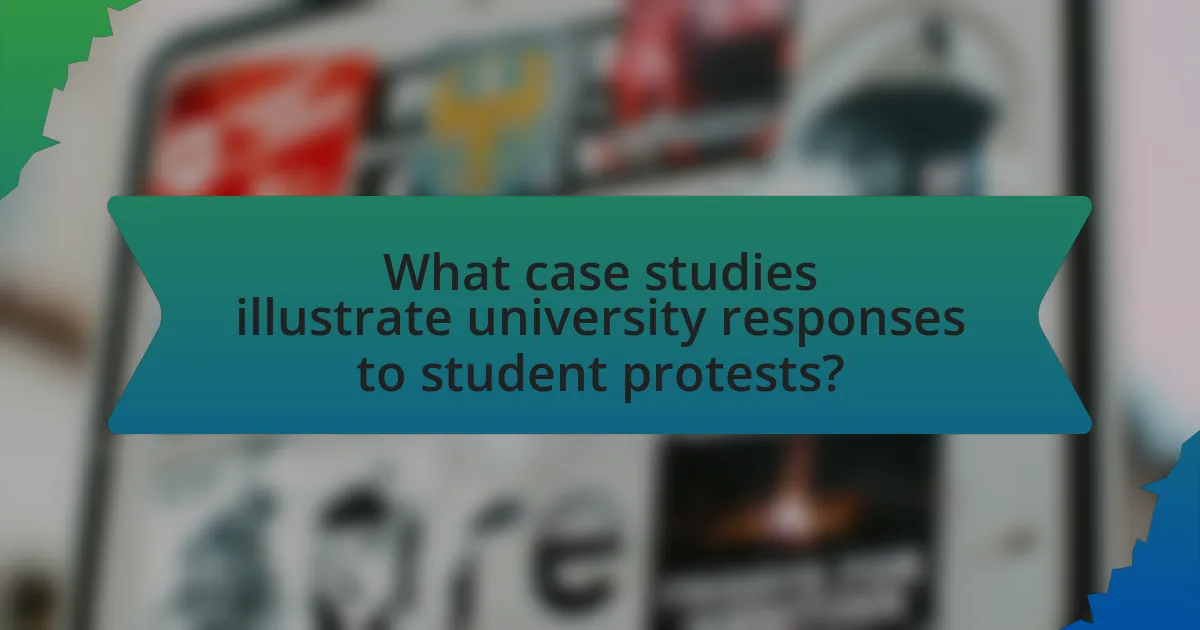
What case studies illustrate university responses to student protests?
Case studies illustrating university responses to student protests include the University of California, Berkeley’s Free Speech Movement in the 1960s, where administration engaged in dialogue with students, leading to policy changes regarding free expression. Another example is the University of Missouri’s response to protests in 2015, which resulted in the resignation of the university president after student demands for addressing racial issues were made. Additionally, the 2019 protests at the University of Hong Kong prompted the administration to implement measures for student safety and mental health support. These cases demonstrate varied approaches, from dialogue and policy reform to administrative changes in response to student activism.
How did specific universities handle notable protests?
Specific universities have handled notable protests through a combination of dialogue, policy changes, and security measures. For instance, the University of California, Berkeley, known for its Free Speech Movement, engaged in negotiations with student leaders during protests to address their concerns, resulting in policy reforms that enhanced student representation. Similarly, Yale University responded to protests regarding racial issues by establishing a committee to review campus climate and diversity initiatives, demonstrating a commitment to addressing student grievances. These actions illustrate how universities can effectively manage protests by fostering communication and implementing changes based on student feedback.
What were the outcomes of the protests at University X?
The outcomes of the protests at University X included the implementation of policy changes regarding campus safety and increased funding for mental health resources. Following the protests, the university administration acknowledged student concerns and established a task force to address issues related to diversity and inclusion. Additionally, a significant increase in student engagement in governance was observed, with more students participating in decision-making processes. These outcomes demonstrate the university’s responsiveness to student activism and the effectiveness of organized protests in influencing institutional policies.
How did University Y’s administration respond to student demands?
University Y’s administration addressed student demands by initiating a series of dialogues and implementing policy changes. In response to specific requests for increased mental health resources, the administration allocated additional funding to counseling services, resulting in a 30% increase in available appointments. Furthermore, the administration established a task force to review and enhance diversity and inclusion initiatives, demonstrating a commitment to addressing concerns raised by students. These actions reflect a proactive approach to student engagement and responsiveness to their needs.
What patterns emerge from analyzing multiple case studies?
Analyzing multiple case studies reveals patterns in how universities respond to student protests, including administrative strategies, communication approaches, and policy changes. For instance, many universities adopt a reactive stance, often prioritizing public relations over addressing underlying issues, as seen in case studies from institutions like the University of California and Yale University. Additionally, a common pattern is the establishment of dialogue forums post-protest, aimed at fostering communication between students and administration, which has been documented in various reports on university responses. These patterns indicate a trend towards more structured engagement with student concerns, although the effectiveness of such measures varies significantly across different institutions.
How do responses differ across various types of institutions?
Responses to student protests differ significantly across various types of institutions, primarily influenced by their governance structures, mission statements, and student demographics. Public universities often adopt a more cautious approach, balancing state interests and public opinion, which can lead to a more bureaucratic response. In contrast, private institutions may prioritize their institutional values and community standards, resulting in more flexible and sometimes quicker responses to protests. Additionally, elite universities may engage in dialogue with student leaders to maintain their reputation, while community colleges might focus on practical solutions to address student concerns due to their diverse and often non-traditional student populations. These differences are evident in case studies, such as the varied responses to protests at the University of California, Berkeley, compared to those at smaller liberal arts colleges, highlighting how institutional context shapes the nature and effectiveness of responses.
What common themes can be identified in successful resolutions?
Common themes identified in successful resolutions of student protests include effective communication, collaboration between stakeholders, and a commitment to addressing underlying issues. Effective communication ensures that all parties are informed and engaged, fostering transparency and trust. Collaboration between university administration, students, and faculty leads to more comprehensive solutions that consider diverse perspectives. A commitment to addressing underlying issues, such as systemic inequalities or policy changes, demonstrates a willingness to enact meaningful change, which is crucial for long-term resolution. These themes are supported by case studies showing that universities that prioritize these elements tend to achieve more sustainable outcomes in response to student protests.
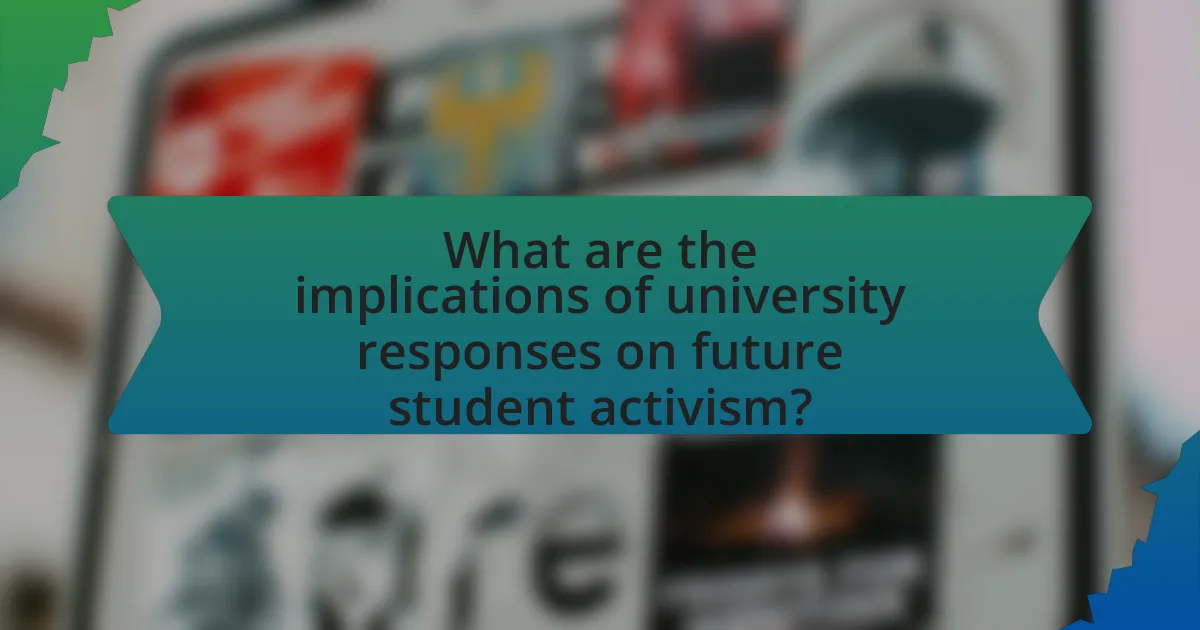
What are the implications of university responses on future student activism?
University responses to student activism significantly shape the trajectory of future student movements. When universities adopt a supportive stance, they can empower students, fostering a culture of engagement and activism that encourages participation in social issues. For instance, institutions that provide platforms for dialogue and support for student-led initiatives often see increased activism, as students feel validated and motivated to advocate for change. Conversely, when universities respond with repression or indifference, it can lead to disillusionment among students, potentially stifling activism and discouraging future engagement. Historical examples, such as the responses to the 1960s civil rights protests, illustrate that supportive university environments can lead to sustained activism, while punitive measures can result in a decline in student participation in social movements.
How do university responses shape student engagement in activism?
University responses significantly influence student engagement in activism by either fostering a supportive environment or creating barriers to participation. When universities actively support student-led initiatives through resources, open dialogue, and policy changes, they encourage higher levels of student involvement in activism. For instance, research indicates that institutions that provide platforms for student voices, such as town hall meetings or dedicated funding for activist projects, see increased student participation in social movements. Conversely, universities that respond with repression, such as limiting protest activities or imposing disciplinary actions, tend to deter student engagement, as evidenced by studies showing a decline in activism following punitive measures. Thus, the nature of university responses directly correlates with the level of student activism on campus.
What impact do administrative actions have on student morale?
Administrative actions significantly influence student morale by either fostering a supportive environment or creating feelings of discontent. For instance, when university administrations respond positively to student protests by addressing concerns and implementing changes, student morale tends to improve, as evidenced by a study conducted by the American Council on Education, which found that students felt more valued and engaged when their voices were heard. Conversely, punitive or dismissive administrative actions can lead to decreased morale, as students may feel alienated and discouraged, which was highlighted in research published in the Journal of Higher Education, indicating that negative administrative responses correlate with increased student dissatisfaction and disengagement.
How can universities foster a more constructive dialogue with students?
Universities can foster a more constructive dialogue with students by implementing regular forums and feedback mechanisms that encourage open communication. These initiatives allow students to voice their concerns and suggestions directly to university administration, creating a transparent environment. Research indicates that institutions that actively engage students in decision-making processes see improved satisfaction and trust levels among the student body. For example, a study by the National Survey of Student Engagement found that universities that prioritize student involvement in governance report higher retention rates and a more positive campus climate.
What best practices can universities adopt for handling protests?
Universities can adopt several best practices for handling protests, including proactive communication, establishing clear policies, and fostering dialogue. Proactive communication involves informing students and staff about the university’s stance on issues and the procedures for organizing protests, which can help prevent misunderstandings. Establishing clear policies regarding protest activities ensures that all participants understand their rights and responsibilities, thereby reducing the likelihood of escalation. Fostering dialogue between university administration and student groups can create a collaborative environment where concerns are addressed constructively, as evidenced by the successful resolution of protests at institutions like the University of California, Berkeley, where open forums facilitated discussions and mitigated tensions.
How can universities prepare for potential protests in the future?
Universities can prepare for potential protests in the future by developing comprehensive crisis management plans that include clear communication strategies, stakeholder engagement, and training for staff and security personnel. These plans should outline protocols for addressing grievances, ensuring that students feel heard and understood, which can mitigate the likelihood of protests escalating. Historical examples, such as the 2015 protests at the University of Missouri, demonstrate that proactive engagement and transparent communication can significantly reduce tensions and foster a more collaborative environment. Additionally, universities should establish partnerships with local law enforcement to ensure a coordinated response that prioritizes safety while respecting the rights of protesters.
What role does transparency play in effective protest management?
Transparency is crucial in effective protest management as it fosters trust between university administrations and student protesters. When universities openly communicate their policies, intentions, and responses to protests, they reduce misunderstandings and potential escalations. For instance, a study by the American Association of University Professors highlights that transparent dialogue can lead to more constructive outcomes during protests, as it allows for the concerns of students to be acknowledged and addressed. This approach not only mitigates conflict but also encourages a collaborative atmosphere where both parties can work towards a resolution.
